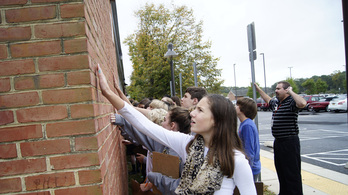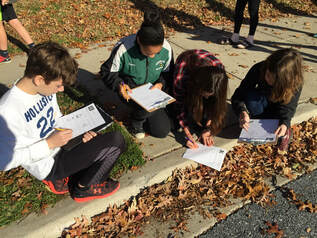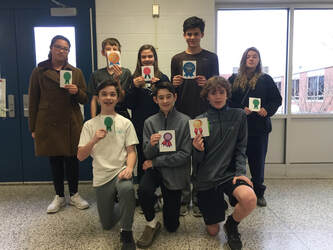Systemic Sustainability: 1.1 Curriculum and Instruction
8th Grade Investigation: Weathering
 2016: Students study the impact of weathering and erosion
2016: Students study the impact of weathering and erosion
Eighth grade students study weather as part of their science curriculum. While this is a concept that every student already has an understanding of, Mr. Philip helps them to draw a connection that strengthens their understanding.
Rain, hail, snow, wind, etc., are all examples of weather that the students know. Now, they are made to observe the long term effect of weather. Their teacher comments that their school is large and strong, having stood there for years, seemingly immune to everything happening around it. Students take a much closer look, using their sense of touch to reveal the fact that weather is a strong and powerful force. Even brick, as strong as it is, is not immune to weather’s reach. As the photo shows, students look to find evidence of weather’s impact on their school’s brick walls. They uncover change in color, evidence of erosion from both wind and water, to name a few. Nature changes things, even the largest and strongest of things, over time.
Students observe closely the changes and impact of weathering. They take this idea further, considering not only the impact of weather on the environment, but also human behavior. Obviously, weather is beyond human control; we can only react and respond to it. However, we can make choices and control much of what we, as people do, that negatively affects the natural world. Paralleling this concept, natural effects of weather versus the impact of human behavior, help students to consider their own choices and behavior as it relates to the environment, particularly the Bay and it’s watershed.
Student Work Lab Sheet
As a cross-curricular arts integration activity, students participated in a weathering photo contest. Students looked for examples of weathering near their homes and neighborhoods. They captured the images with their phones and cameras and submitted the paperless photos via Google Classroom. Mr. Philip and Mrs. Shelleman prepared slideshows of the images and allowed the students to vote on winners for various categories.
Student Photo Contest Entry
Rain, hail, snow, wind, etc., are all examples of weather that the students know. Now, they are made to observe the long term effect of weather. Their teacher comments that their school is large and strong, having stood there for years, seemingly immune to everything happening around it. Students take a much closer look, using their sense of touch to reveal the fact that weather is a strong and powerful force. Even brick, as strong as it is, is not immune to weather’s reach. As the photo shows, students look to find evidence of weather’s impact on their school’s brick walls. They uncover change in color, evidence of erosion from both wind and water, to name a few. Nature changes things, even the largest and strongest of things, over time.
Students observe closely the changes and impact of weathering. They take this idea further, considering not only the impact of weather on the environment, but also human behavior. Obviously, weather is beyond human control; we can only react and respond to it. However, we can make choices and control much of what we, as people do, that negatively affects the natural world. Paralleling this concept, natural effects of weather versus the impact of human behavior, help students to consider their own choices and behavior as it relates to the environment, particularly the Bay and it’s watershed.
Student Work Lab Sheet
As a cross-curricular arts integration activity, students participated in a weathering photo contest. Students looked for examples of weathering near their homes and neighborhoods. They captured the images with their phones and cameras and submitted the paperless photos via Google Classroom. Mr. Philip and Mrs. Shelleman prepared slideshows of the images and allowed the students to vote on winners for various categories.
Student Photo Contest Entry


